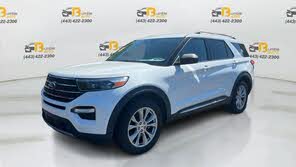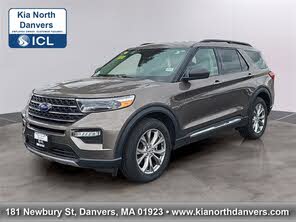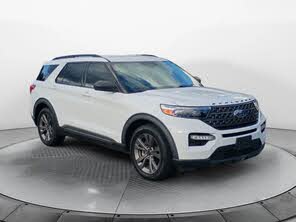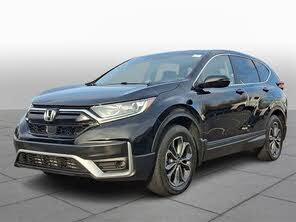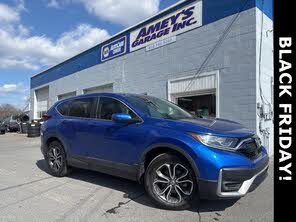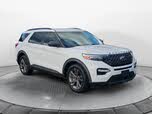2021 Ford Explorer vs 2021 Honda CR-V
Overview | |
MSRP$32,925 | MSRP$25,350 |
Listings2299 | Listings1266 |
Ratings & Reviews | |
User Reviews | User Reviews |
Expert reviews7.5 out of 10 | Expert reviews7.8 out of 10 |
Pros
Cons
| Pros
Cons
|
2021 Ford Explorer Reviews SummaryThere was a time when everybody in America seemingly drove an Explorer. That may be an exaggeration, but not by much. In its first four years of production, Ford sold over a million examples. In 1998, Ford was selling its second-generation Explorer at a rate of nearly 440,000 per year. Whether your family purchased an Explorer or not, this was the nameplate that invented the midsize SUV segment. Fast forward to the 2021 model year and the Explorer is in its sixth generation. It's now a three-row SUV that clocks in at a maximum of 4,700 pounds, with a price tag north of $50,000 for the Explorer Platinum trim level. Long gone are the days when it was the only game in town. Almost every automaker has a competitor. So how does the Explorer shake out for 2021? | |
2021 Honda CR-V Reviews SummaryEven in a grim year, Honda is selling a staggering number of CR-Vs. The CR-V is the best-selling Honda by far. It’s also the second best-selling compact SUV, just behind the Toyota RAV4. And it's the fifth best-selling vehicle in the U.S., and if you take out all the commercial sales of full-size pickups it’s one of the two best-selling vehicles year in and year out. So it’s hard to argue against the CR-V formula. Honda’s been at this almost as long as crossovers have been a thing, launching the CR-V in 1997—a year after the RAV4 debuted. The funny thing is, aside from sales volume, there’s only one thing the CR-V particularly excels at. Aesthetics are subjective, but it would be hard to argue the CR-V is the best looking vehicle in its class. It’s not the cheapest. It’s not the best equipped, especially at the middle to lower trim levels. It’s not the fastest, nor is it the quietest, or the most fuel efficient. It’s not even the most reliable, showing up nowhere in J.D. Power's Most Reliable list. So what makes it so appealing to American consumers? Let’s see if we can figure that out. | |
No video found | No video found |
Popular Features & Specs | |
Engine2.3L 300 hp I4 | Engine1.5L 190 hp I4 |
Drive TrainRWD | Drive TrainFWD |
Seating Capacity7 | Seating Capacity5 |
Horsepower | Horsepower190 hp @ 5600 rpm |
MPG City21 | MPG City28 |
MPG Highway28 | MPG Highway34 |
Engine | |
Engine Name2.3L 300 hp I4 | Engine Name1.5L 190 hp I4 |
Torque | Torque179 lb-ft @ 2000 rpm |
Horsepower | Horsepower190 hp @ 5600 rpm |
DrivetrainRWD | DrivetrainFWD |
Fuel Economy | |
MPG City21 | MPG City28 |
MPG Highway28 | MPG Highway34 |
Interior | |
Seating Capacity7 | Seating Capacity5 |
Safety | |
Front Crash Overall5 | Front Crash Overall5 |
Side Crash Overall5 | Side Crash Overall5 |
Dimensions & Capacity | |
Cargo Space18.2 cu ft | Cargo Space39.2 cu ft |
Curb Weight4345 lbs | Curb Weight3337 lbs |
Height69.9 in | Height66.1 in |
Length198.8 in | Length182.1 in |
Width89.3 in | Width73.0 in |
Wheelbase119.1 in | Wheelbase104.8 in |
Maximum Payload1425 lbs | Maximum Payload1358 lbs |
Number of doors4 | Number of doors4 |
Maximum Towing Capacity5300 lbs | Maximum Towing Capacity1500 lbs |
Overview | ||
MSRP | $32,925 | $25,350 |
Listings | ||
Ratings & Reviews | ||
User reviews | ||
Expert reviews | 7.5 out of 10Read full review | 7.8 out of 10Read full review |
Pros & cons | Pros
Cons
| Pros
Cons
|
Summary | There was a time when everybody in America seemingly drove an Explorer. That may be an exaggeration, but not by much. In its first four years of production, Ford sold over a million examples. In 1998, Ford was selling its second-generation Explorer at a rate of nearly 440,000 per year. Whether your family purchased an Explorer or not, this was the nameplate that invented the midsize SUV segment. Fast forward to the 2021 model year and the Explorer is in its sixth generation. It's now a three-row SUV that clocks in at a maximum of 4,700 pounds, with a price tag north of $50,000 for the Explorer Platinum trim level. Long gone are the days when it was the only game in town. Almost every automaker has a competitor. So how does the Explorer shake out for 2021? | Even in a grim year, Honda is selling a staggering number of CR-Vs. The CR-V is the best-selling Honda by far. It’s also the second best-selling compact SUV, just behind the Toyota RAV4. And it's the fifth best-selling vehicle in the U.S., and if you take out all the commercial sales of full-size pickups it’s one of the two best-selling vehicles year in and year out. So it’s hard to argue against the CR-V formula. Honda’s been at this almost as long as crossovers have been a thing, launching the CR-V in 1997—a year after the RAV4 debuted. The funny thing is, aside from sales volume, there’s only one thing the CR-V particularly excels at. Aesthetics are subjective, but it would be hard to argue the CR-V is the best looking vehicle in its class. It’s not the cheapest. It’s not the best equipped, especially at the middle to lower trim levels. It’s not the fastest, nor is it the quietest, or the most fuel efficient. It’s not even the most reliable, showing up nowhere in J.D. Power's Most Reliable list. So what makes it so appealing to American consumers? Let’s see if we can figure that out. |
Video | No video found | No video found |
Popular Features & Specs | ||
Engine | 2.3L 300 hp I4 | 1.5L 190 hp I4 |
Drive Train | RWD | FWD |
Seating Capacity | 7 | 5 |
Horsepower | 190 hp @ 5600 rpm | |
MPG City | 21 | 28 |
MPG Highway | 28 | 34 |
Engine | ||
Engine Name | 2.3L 300 hp I4 | 1.5L 190 hp I4 |
Torque | 179 lb-ft @ 2000 rpm | |
Horsepower | 190 hp @ 5600 rpm | |
Drivetrain | RWD | FWD |
Fuel Economy | ||
MPG City | 21 | 28 |
MPG Highway | 28 | 34 |
Interior | ||
Seating Capacity | 7 | 5 |
Safety | ||
Front Crash Overall | 5 | 5 |
Side Crash Overall | 5 | 5 |
Dimensions & Capacity | ||
Cargo Space | 18.2 cu ft | 39.2 cu ft |
Curb Weight | 4345 lbs | 3337 lbs |
Height | 69.9 in | 66.1 in |
Length | 198.8 in | 182.1 in |
Width | 89.3 in | 73.0 in |
Wheelbase | 119.1 in | 104.8 in |
Maximum Payload | 1425 lbs | 1358 lbs |
Number of doors | 4 | 4 |
Maximum Towing Capacity | 5300 lbs | 1500 lbs |
The 2021 Ford Explorer turned heads and stood out in its category, despite the fact it bore a striking resemblance to its other “E”-series siblings. With models ranging from the Escape to the Expedition, Ford had created a cohesive family of SUVs that evoked a nostalgic sense of brand loyalty reminiscent of car manufacturers in the 1950s. The Explorer's sporty, raked belt lines and squinting headlights made it identifiable against its competitors, although discerning between the Explorer and the Edge at a quick glance could be a challenge.
The exterior aesthetics of the Explorer changed substantially with its six different trim levels, starting with the base model at $32,925 and escalating to the Platinum at $52,730. The variety included different grille designs—from black to full chrome depending on the trim, ensuring each upgrade brought a touch of uniqueness. Inside, three rows of seats were standard across all trims, with varying levels of comfort and luxury as one climbed the trim ladder. The base model offered cloth upholstery and reasonably comfortable seating, though the third row remained cramped for adults.
The Explorer's interior was marked by a clean dash, familiar gauges, and a dominant 8-inch LCD touchscreen infotainment system. The center console featured practical elements like large knobs and buttons for audio and climate controls, alongside a rotary gearshift and multiple storage bins and cupholders. The XLT trim, the most popular according to the Explorer Order Guide with an expected 56% consumer preference, added features like a power front passenger seat and improved finishes. Leather upholstery became standard at the mid-tier Limited trim and higher.
In contrast, the 2021 Honda CR-V faced some criticism for its similarity to almost every other compact crossover in the market. Commentators noted that while the CR-V had some distinguishing features like its grille and plastic chrome accents, its overall design was not particularly unique. Offered in eight colors, the palette was largely dominated by conservative shades with only a few vibrant options available, predominantly on higher trims.
Inside, the CR-V accommodated black, gray, and ivory themes with either cloth or leather, based on trim. As you ascended the trims, additional upscale features like wood panels and more chrome accents were introduced. The seats themselves were more angular compared to some competitors, giving a modern edge to the interior design, yet other crossovers like the Kia Sportage and Hyundai Tucson boasted more distinctive and appealing styling in their mid-tier trims.
















Those seeking more power could opt for trims featuring the 3.0-liter EcoBoost twin-turbo V6 engine, providing 365 hp and 380 lb-ft of torque, or the sport-oriented Explorer ST, which boosted performance to 400 hp and 415 lb-ft of torque. Despite these figures, the Explorer’s primary focus was not on providing an engaging driving experience but on practicality—such as its towing capacity, which ranged between 5,000 pounds and 5,600 pounds based on configuration.
On the other side, the Honda CR-V wasn’t designed for sports-like performance but offered smooth and steady acceleration suited for everyday scenarios. Powered by a 190-hp turbocharged four-cylinder engine across all trims, the CR-V managed a 0 to 60 mph time of around 7.8 seconds, which was respectable for the segment but obviously not sporty. The continuously variable transmission (CVT) emphasized efficiency over engagement, contrasting with competitors like the Kia Sportage and Hyundai Tucson that offered more conventional eight-speed automatics with sport modes.
The CR-V came standard with front-wheel drive, with all-wheel drive as an option. The suspension setup included MacPherson strut in the front and a multi-link system in the rear, ensuring predictable handling and decent ride quality consistent with class standards.
When comparing the 2021 Ford Explorer and the 2021 Honda CR-V in terms of interior space and functionality, distinct differences emerged. The base Explorer featured seating for seven, reducing to six with captain’s chairs in the second row on all other trims. Offering 39 inches of second-row legroom, it positioned itself among practical mid-sized SUVs, just slightly trailing competitors like the Mazda CX-9 and Chevrolet Blazer, while falling well behind the roomier Kia Telluride and Hyundai Palisade.
The Explorer’s cargo capacity was one of its key selling points, providing 21 cubic feet with the third row in use, expanding to 81 cubic feet with the rear seats folded. Despite being spacious, it fell short of competitors like the Kia Telluride, which continued to offer better overall cargo space.
On the practical front, the CR-V focused on fitting five passengers comfortably while enabling solid storage space. It provided 102.9 cubic feet of passenger volume, surpassing the Toyota RAV4 by four cubic feet. With the rear seats up, the CR-V's cargo space was marginally better than the RAV4’s, and it expanded to 75.8 cubic feet with the seats folded—sufficient for most family needs.
Accessing the cargo area varied by trim; the base models had a manual liftgate, while higher trims offered power and hands-free options, the latter proving to be a convenient feature when carrying heavy items.
The 2021 Ford Explorer didn’t skimp on technology, providing an 8-inch touchscreen as standard even on the base model. This included modern essentials like AM/FM radio, SiriusXM, Apple CarPlay, and Android Auto, complemented by a 4G WiFi hotspot and the Sync 3 system. Upgrading to the Limited trim introduced a high-quality 12-speaker Bang & Olufsen audio system and HD radio, with options for a larger 10.1-inch touchscreen and up to 14 B&O speakers in the highest trims.
The Explorer also facilitated charging with multiple USB ports and five 12-volt power points, with a 110-volt AC outlet standard on the ST and optional on the Limited trim, and a wireless charging pad standard from the Limited trim upwards.
Conversely, the base CR-V LX lagged with a 5-inch screen offering limited functionality beyond Bluetooth. Higher trims made a significant leap with a 7-inch high-definition touchscreen that included Apple CarPlay, Android Auto, and more. Audio quality improved with each trim, climaxing with a 300-watt system in the Touring trim. The EX and higher trims featured Sirius XM and HD radio, with only the top-tier Touring offering satellite navigation and a wireless phone charger.
Charging options in the CR-V varied by trim, with multiple USB ports and a 12-volt outlet standard in most trims, escalating to include a wireless charger in the Touring edition.
The Ford Explorer excelled in safety, earning the IIHS Top Safety Pick+ award and top scores on all crash tests except for an “Acceptable” rating for adaptive headlights. However, advanced safety features were not universally standard across all trims. The base model included the Ford Co-Pilot360 suite—comprising auto high-beams, blind-spot monitoring, rear cross-traffic alert, lane-keeping assist, forward-collision warning, and more. Additional features like adaptive cruise control, evasive steering assist, and speed sign recognition required at least the Limited trim.
Safety was arguably the standout attribute for the 2021 Honda CR-V. It achieved a five-star NHTSA rating and a Top Safety Pick award from IIHS, missing out on the highest Top Safety Pick+ rating only due to headlight performance and child seat anchor ease.
Honda’s commitment to safety extended to making the comprehensive Honda Sensing suite standard across all trims. This included essential features like a multi-angle rearview camera, forward collision warning, lane departure warning, automatic emergency braking, road departure mitigation, lane-keeping assist, and adaptive cruise control. Only the base LX trim lacked blind spot monitoring, which became standard on the EX and higher trims.
CarGurus highlights

According to CarGurus experts, the overall rating for the 2021 Ford Explorer is 7.5 out of 10, while the 2021 Honda CR-V scores 7.8 out of 10. Despite the Ford Explorer offering several benefits like advanced tech options and higher towing capacity, the Honda CR-V pulls ahead in safety, practicality, and overall consumer satisfaction. Therefore, based on these ratings, the 2021 Honda CR-V is the better choice for most consumers.
Choose the 2021 Ford Explorer if:
- You need to tow heavy loads: The Explorer’s towing capacity of up to 5,600 pounds suits it for pulling trailers or larger boats.
- You prefer advanced technology: Higher trims, especially, come loaded with luxury tech options like Bang & Olufsen audio systems and larger touchscreen displays.
- You want a mid-size SUV with a third row: Offering up to seven seats and reasonable comfort, the Explorer is good for larger families.
Choose the 2021 Honda CR-V if:
- Safety is your top priority: The CR-V includes an extensive array of safety features as standard across all trims.
- Fuel efficiency matters: The smaller, lighter body and focus on economical engines make the CR-V more fuel-efficient.
- You need versatile cargo space: The CR-V’s ample cargo and passenger space, with easy-to-use power tailgate options, make it practical for various needs.
CarGurus highlights

According to CarGurus experts, the overall rating for the 2021 Ford Explorer is 7.5 out of 10, while the 2021 Honda CR-V scores 7.8 out of 10. Despite the Ford Explorer offering several benefits like advanced tech options and higher towing capacity, the Honda CR-V pulls ahead in safety, practicality, and overall consumer satisfaction. Therefore, based on these ratings, the 2021 Honda CR-V is the better choice for most consumers.
Choose the 2021 Ford Explorer if:
Shop Now- You need to tow heavy loads: The Explorer’s towing capacity of up to 5,600 pounds suits it for pulling trailers or larger boats.
- You prefer advanced technology: Higher trims, especially, come loaded with luxury tech options like Bang & Olufsen audio systems and larger touchscreen displays.
- You want a mid-size SUV with a third row: Offering up to seven seats and reasonable comfort, the Explorer is good for larger families.
Choose the 2021 Honda CR-V if:
Shop Now- Safety is your top priority: The CR-V includes an extensive array of safety features as standard across all trims.
- Fuel efficiency matters: The smaller, lighter body and focus on economical engines make the CR-V more fuel-efficient.
- You need versatile cargo space: The CR-V’s ample cargo and passenger space, with easy-to-use power tailgate options, make it practical for various needs.

By: CarGurus + AI
At CarGurus, our team of experienced automotive writers remain at the heart of our content operation, conducting hands-on car tests and writing insightful guides that are backed by years of industry experience. To complement this, we are harnessing AI to make our content offering more diverse and more helpful to shoppers than ever. To achieve this, our AI systems are based exclusively on CarGurus content, ratings and data, so that what we produce is both unique to CarGurus, and uniquely helpful to car shoppers.





